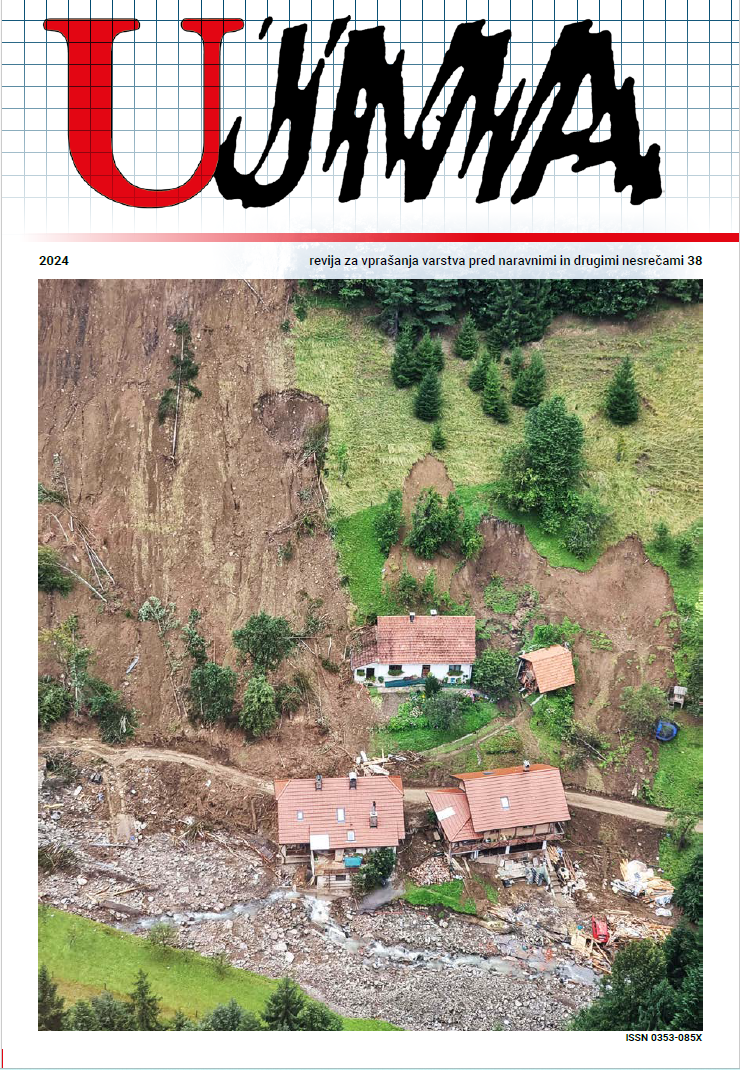CRITICAL CARE OF THE INJURED IN CAVES
Abstract
Caving explores the underground world and contributes to the understanding of water circulation underground, the structure of karst, and the discovery of new animal species and minerals. Caving is well-developed in Slovenia, with around 500 newly registered caves annually. Cave Rescue Service (JRS), a permanent service of the Caving Association of Slovenia, offers help and rescue in the event of accidents in caves, and operates within the protection and rescue system under the Republic of Slovenia‘s Administration for Civil Protection and Disaster Relief. Caving requires physical and mental fitness. Cavers are exposed to dangers such as slips, falls, injuries from falling rocks, hypothermia and disorientation. In the event of an accident in the caves, fast, coordinated action by the rescue service is key. An intervention in Vranjedolska cave shows the coordination of the JRS and cooperation with other units of the protection and rescue (ZiR) system. Medical care in caves is a special challenge, adapted to the environment, with the aim of ensuring good medical care until arrival at hospital. During the rescue in Vranjedolska cave, the members of the team for widening the passages at the JRS prepared a suitable evacuation route for the injured person, which requires experience, expertise and careful planning. Rescue in caves requires logistically coordinated cooperation of many teams within the JRS and the ZiR system.
References
Badino, G., Verša, D., 1998. Jame in jamarji. Ljubljana, Jamarska zveza Slovenije, 50.
Jamarska zveza Slovenije http://www.jamarskazveza.si/images/Documents/Interni%20akti/Pravilnki/merila_JRS_2020.pdf.
Jamarska zveza Slovenije, https://www.jamarska-zveza.si/index.php/strokovne-sluzbe/ss-kataster-jam.
Knutson, S. & Putnam, W. O. American caving accidents. Natl Speleol Soc News.
Merela, M., 2016. Jamarska reševalna služba Slovenije – ekipa za širjenje ožin ob nesreči v jami. Ujma, 30, 291–299.
Merela, M., 2018. Mednarodno sodelovanje Jamarske reševalne službe in razvoj enote Cave SAR Slovenija. Ujma, 32, 276−283.
Mihalič, K., 2023. Prostovoljsko delo v jamarski reševalni službi in njegov vpliv na zagotavljanje zmožnosti operativnega delovanja. Diplomsko delo.
Petrucci, E., Pizzi, B., Scimia, P., Conti, G., Di Carlo, S., Santini, A., Fusco, P., 2018. Wireless and Low-Weight Technologies: Advanced Medical Assistance During a Cave Rescue: A Case Report. WILDERNESS & ENVIRONMENTAL MEDICINE, 29, 248–251.
Schneider, T. M., Bregani, R., Stopar, R., Krammer, J., Göoksu, M., Müller, N., Petermeyer, M., Schiffer, J., Strapazzon, G., 2016. Medical and logistical challenges of trauma care in a 12-day cave rescue: A case report. Injury, 47, 280–283.
Stella-Watts, A. C., Holstege, C. P, Lee, J. K. , Charlton, N. P., 2012. The Epidemiology of Caving Injuries in the United States. Wilderness & environmental medicine, 23, 215–222.
Wharton, D. R., Mortimer, R. B., 2011. Rhabdomyolysis after Prolonged Suspension in a Cave. Wilderness & environmental medicine, 22, 52–53.
Zakon o rudarstvu (ZRud-1), Uradni list RS, št. 14/14 – uradno prečiščeno besedilo, 61/17 – GZ, 54/22 in 78/23 – ZUNPEOVE.
Zakon o varstvu podzemnih jam (ZVPJ), Uradni list RS, št. 2/04, 61/06 – ZDru-1, 46/14 – ZON-C in 21/18 – ZNOrg.
Downloads
Published
Issue
Section
License
Copyright (c) 2025 Ujma

This work is licensed under a Creative Commons Attribution-NonCommercial-NoDerivatives 4.0 International License.
The articles are made available to the public under Creative Commons Attribution-NonCommercial-NoDerivatives 4.0 International (CC BY-NC-ND 4.0).


